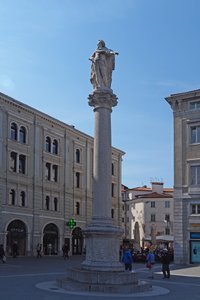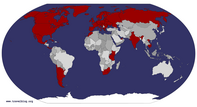Advertisement
Published: July 16th 2020

 Charles VI, Holy Roman Emperor, 1719
Charles VI, Holy Roman Emperor, 1719
Celebrating his declaration of Trieste as a free portOur guide in
Trieste, Suzi, was a serious person and a wonderful teacher. She brought a binder full of maps. Showing us the local geography and national boundaries was helpful in our gaining a bit more understanding of the complex history of the Adriatic area. Trieste changed nationalities seven time in relatively modern times. It was part of the Austro-Hungarian Empire, which the government invited in as a defence against Venetian hegemony. For thirty years it was occupied by Napoleon, who in this area was defeated by the Austro-Hungarian Empire. After WWI Mussolini was granted the city for the Italians and changed its character for twenty years, persecuting Slavs and Croatians. Endemic fascist tendencies resulted in the city being on the wrong side of WWII. For some years it was almost part of Slovenia, but a treaty gave the city to the Italian nation. We fortunate North-Americans found it hard to put ourselves in the shoes of people subjected so frequently to such fundamental changes – no wonder family identity is potent.
Trieste’s magnificent main buildings are from the late period of the Austro-Hungarian Empire, when it was trying to consolidate its influence. Monumental public and insurance buildings line the

 Roman amphitheatre 1 century
Roman amphitheatre 1 century
Occasional music performancesgrand Piazza Unità d'Italia, on reclaimed land that used to be the port. Almost out of sight on a very tall plinth is the statue of
Charles VI, the father of
Maria Theresa, the last sovereign in the Hapsburg dynasty. He points to the harbour that he designated as free port in the
Holy Roman Empire. Now the port is less important, and a quiet canal offers shelter to small boats and yachts.
Not far away, we were seduced by rows of market stalls, offering many bee products, dazzling displays of vegetables, brightly blooming bedding-out plants, charcuterie, pastries, leather goods and some exotic items, the most extraordinary of which were Nepalese prayer bowls. Even Suzi fell under the influence of the colourful fresh foods. She showed us wild asparagus, a delicacy we had eaten on the Istrian peninsula. The tables filled with spices tempted me to buy, a ridiculous idea since taking home unsealed powered substances would have been fraught with problems. The range of paprikas reminded me how close we were to Hungary.
Eventually, we turned our attention to a magnificent Serbian Orthodox church, set right on the street. Inside, gold ornamentation glittered in the wavering light of dozens of tall

 Mussolini era building 1938
Mussolini era building 1938
across the street from the Roman Amphitheatrecandles. The barrel-vaulted ceiling and walls were highly decorated with murals and framing designs. Several locals had stepped in for a few moments of worship.
Trieste’s excavated Roman amphitheatre is across the street from the Mussolini-era buildings. Suzi explained that Mussolini had visited Trieste several times and paid for the expensive archeological work as a demonstration that this crucial city had proud Roman roots. In our times, in the old city, any hint of Roman stone halts modern construction while archeologists excavate the ruins. Good for history, hard on land owners.
We threaded our way through the narrow streets of “
The Ghetto”, now mostly Jewish, but originally inhabited by foundry workers, as is the derivation of the word. Suzi showed us an old, still-operating drinking fountain, once a luxury for surrounding households. The buildings were well maintained, and to our delight there were two used-book shops. Of course, none of us could read the books, so we passed by without entering. We did make purchases at the excellent
Marco’s Gelateria , where I had a delicious non-dairy carmelito (caramel-chocolate) and banana cone.
We walked away from the main square and up into the old city, which had ruins of
Roman villas immediately beside and even under low-rise homes built in later times. The very narrow, steep, winding streets were designated for pedestrians now. Personality shone from small windows with pretty flower boxes.
For lunch we returned to Bartellomo’s on the main square, where we ate dinner last night. I so liked the octopus salad I had shared with Lelia that I ordered another one for lunch, with alcohol-free beer. The major breweries supply tasty alcohol-free beers, making it pleasurable to drink at lunch and yet keep my head for our afternoon.
Back on the bus, we were on our way to Slovenia. The border-crossing was marked only by a sign, because both Italy and Slovenia are in the European Union. Tomas told me that lots of people cross the border to buy petrol because the price is cheaper in Slovenia. Plus, two kilometres from the border was a casino.
Also near the border was the original
Lipizzaner stud farm, where this famous breed of white horses are schooled in “
airs above the ground ”, originally for training in cavalry maneuvers and now for entertainment. Disappointingly, we saw no demonstration of the intricate figures in which the horses dance to command.
The entrance was down a long road through white-fenced, green-grassed paddocks, but none of the horses were out. We found them somnolent in the afternoon sun and stabled in the cool indoors. The heat from direct sun is not good for them.
A man who had worked a life-time with horses guided us through the stables, first showing us the mares. In modern times, they breed the mares only every other year, having found that the mares and foals were stronger that way. Unlike historically, the mares do participate in performances now - a strangely modern equality policy.
The horses obviously knew him well because they sniffed and gently butted him the whole time he talked. The last stable was for the stallions. Although they are stabled together, and sometimes perform together, they are never allowed to be together in situations that would raise their testosterone levels, because that would make them unsuitable for training and performing. Riders learn to control the horse only with their legs (historically to keep their sword arm free), practicing on older horses that no long perform but know the figures.
Our guide expressed his lasting grief that five million horses were

 Mare and foals
Mare and foals
Calm, shady, generous spacekilled in WWI, and, by WWII, had no military use at all. He also made a slighting passing comment about the treatment of horses in western rodeos.
An open barn was where the mothers and new-borns were together resting and nursing. The blood-lines are traced through the mares; records of the fathers are kept to avoid in-breeding. Foals are born dark brown and gradually change to white over about six years through a genetic mutation that causes them to go grey, just as human hair does over a much longer period. As we left, we drove by
Lipica, the town that gives the Lipizzaner their name.
In the late afternoon light, we drove through beautiful green rolling hills and small mountains. Agriculture seemed local, not done in great commercial fields. Dotted on the landscape were the red-tiled roofs of farm houses and small villages.
At last we wound our way off the main highway onto smaller roads that curved round the villages until we stopped in one called
Grahovo. Here was our “home stay”, in family-owned
Logar Tourist Farm We were greeted by our host bearing glasses of fruit-based brandy, a charming introduction. The house was immaculate, and the

 Ivanka, chef at Logar
Ivanka, chef at Logar
Preparing chicken noodle soupfittings were quite new, although strangely the towels were hard and worn. Elizabeth and had had almost no floor-space for our suitcases, but that seemed minor. The warm, sunny evening was conducive to a stroll along the village street and up to the church. The grave-yard gave me pause, because the modern marble stones reminded me of how recently war ravaged the country-side, even if Slovenia mostly stay out of it.
Supper was cooked by Vanka, the mother-in-law of the family, who lived elsewhere. She obviously loved cooking and later told me she caters for groups of up to fifty – more than that prevents her from meeting people, her real passion. Susan and Gary, Manka, Tomas and Paul were staying on a different home-stay farm. They joined us for supper at our place, and tomorrow we will join them for supper at their farm. We ate the best chicken noodle soup ever, followed by roasted chicken leg with mashed potatoes and green salad. Red wine, of course. Vanka took my sensitivity to dairy products so seriously that she made me a separate apple strudel without butter – exceedingly crispy pastry around a delicious raisin-apple filling.
View map of trip to date.
Advertisement
Tot: 0.612s; Tpl: 0.014s; cc: 30; qc: 151; dbt: 0.2628s; 1; m:domysql w:travelblog (10.17.0.13); sld: 1;
; mem: 1.5mb



























Isabel Gibson
non-member comment
Another full day. Your point about the effect of more-or-less continual macro-political upheaval is well taken. When the wide world is so changeable, and often dangerously so, it makes sense to restrict one's serious loyalties to family. I love the photos of all the different kinds of asparagus and pepper for sale, and the St. Spyridon altar. Quite a change from the austere churches I grew up with, which almost seemed to flaunt their plainness as a virtue. And regarding the Lipizzanner stud farm, did you read "Airs Above the Ground" by Mary Stewart as a teenager? Amazing the things that travel (even someone else's travel!) can remind you of.